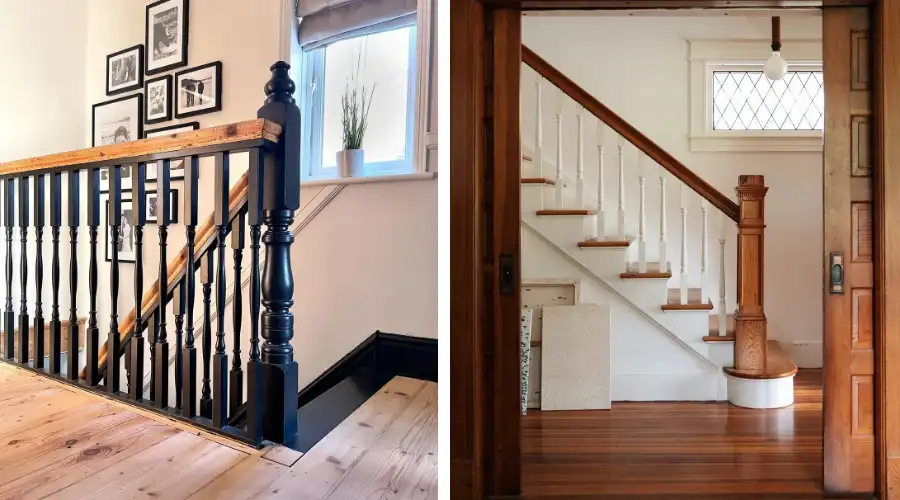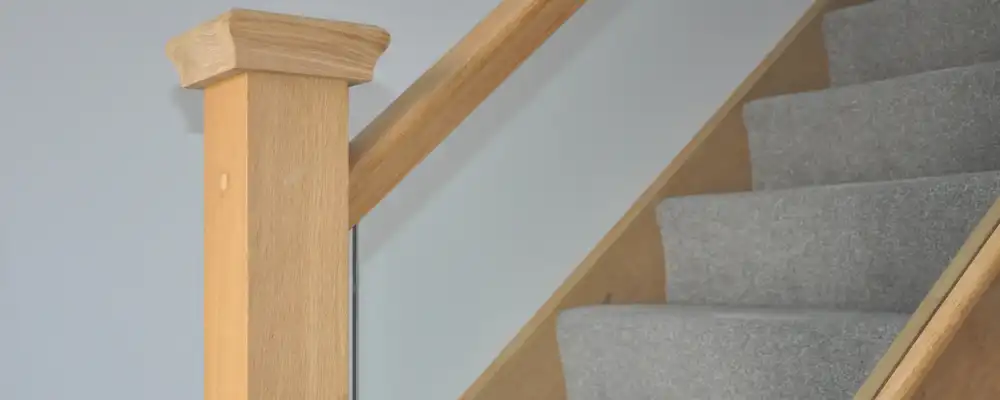In building design and construction, staircases have both structural and aesthetic roles. Among the crucial structural elements that impart strength, alignment, and visual anchorage to stairways is the newel post. Underappreciated at times, the newel post not only carries the handrail system but also contributes to the visual beauty of spiral staircase in residential, commercial, and industrial applications. Continue reading to learn more about this building element.
What is a Newel Post?
A newel post is a vertical structural component located at the start, end, or midpoint of a stair. It supports the handrail and balustrade, carrying lateral loads down to the floor or supporting structure. From an engineering perspective, the newel post provides stability and alignment of the railing system, minimising handrail displacement or failure. It is usually greater in size and heavier than the balusters that accompany it. Newel posts may be structural—either bearing forces and loads—or merely decorative based on the design purpose and location.
Types of Newel Posts Based on Location and Function
Starting Newel Post
Located at the very bottom of a staircase, the starting newel is the main structural anchor for the whole railing system. It fights the initial lateral forces imposed when a user takes hold of the handrail. Usually made larger and more decorative than the other posts, it also makes a visually strong entrance to the stair.
Intermediate or Landing Newel Post
These are fitted at changes of direction or landings of staircases (e.g., L-shaped or U-shaped stairs). They act as support points of crucial importance, maintaining the continuation and alignment of the handrail over multiple flight changes. Intermediate newels also support the load applied when handrails turn corners or change slopes.
Angle Newel Post
Located at sharp directional changes, particularly in geometrically complex staircases, angle newels are essential for managing angular stress. They provide handrail support while retaining the necessary ergonomic and safety angles for users climbing up or down the stairs.\
Types of Newel Posts Based on Design

Box Newel Post
Box newels consist of hollow posts with a square or rectangular shape, which are generally applied to contemporary and craftsman-style homes. Based on their flat tops and hollow interior, they provide potential for hidden wiring or lighting incorporation. When properly installed, they remain structurally reliable and also provide ease in design matching and personalization.
Turned Newel Post
These are detailed with fine lathe-turning and are most commonly constructed of hardwood. Turned newels bring traditional staircases a touch of classic sophistication, particularly in colonial or Victorian styles. Though ornamental, they can also be entirely load-supporting when made of hardwood of sufficient density.
Fluted and Mission Newel
Fluted newels feature vertically grooved designs that create visual height and symmetry. Mission-style newels, however, are utilitarian, square-profile posts with flat caps, which are usually employed in modern and transitional homes where clean lines are desired.
Apart from these common designs, newel posts are also available in other shapes like shaker styles, plain, routered posts, flat and custom-designed.
Benefits of Newel Posts
- Structural Reinforcement
Newel posts serve as terminal load-bearing members that stabilise the handrail system. Without proper newels, balustrades can loosen over time, compromising safety. In engineered stair design, newels are calculated to bear both static and dynamic forces applied through daily use. - Load Transfer and Distribution
The post not only supports vertical weight but also absorbs the torsional and shear stresses introduced by stairway users. Especially in longer stair runs or curved configurations, newels prevent handrails from sagging or shifting laterally. - Visual Anchoring and Aesthetic Appeal
Architecturally, newel posts present a visual focus point for the stairway. Intricately turned or simple, their presence sets a rhythm in the design, enhances the interior, and raises the quality of stair workmanship. - Regulatory Compliance
Codes of construction (e.g., NBC for India, IBC for the US) typically mandate terminations or support of stair railings on newel posts. Properly installed posts guarantee the system complies with regulations regarding height, spacing, and resistance to load, especially in buildings with many floors. - Longevity and Durability
Newel posts prolong the longevity of staircases by providing adequate load management and resisting premature wear-and-tear. Good-quality materials and robust installation practices lead to reduced repairs and maintenance needs spanning decades.
Materials Used for Newel Posts
- Wood
Wood is of high value because it’s strong, versatile and beautiful. The dense grains of hardwoods such as teak, oak and mahogany offer various artistic carvings as well as better load bearing capacity. Softwood varieties like pine are cheaper, but must be adequately protected against moisture and insect infestations. - Metal
Metals such as wrought iron, stainless steel, and aluminium are increasingly being utilized in modern buildings. They can resist corrosion (with the appropriate coatings), are thin in profile, and can carry high tensile loads. Metal newels are best suited to open riser stairs and minimalist rail systems. - Stone
Frequently used for public construction or luxury houses, these have excellent load bearing capacity. Though appealing in terms of looks, installing them is difficult as they are heavy, fragile and require some sort of anchoring. Granite and marble are used for affluent finishes. - Composite Materials (Vinyl, PVC, FRP)
These are great for outdoor, wet environments as they are highly resistant to rot, insects, and UV rays. Vinyl and PVC posts are lightweight and easy to install compared to wood or metal posts and are ideal for deck railings and outdoor staircases.
Newel Post Installation Process
- Site Layout and Measurement
The railing and staircase layout is labeled initially to ensure that newel post locations are in accordance with tread spacing, wall clearance, and landing size. Precise labeling is important to achieve symmetry and load transfer paths. - Base Drilling and Mounting Preparation
A pilot hole or core hole is drilled depending on the type of floor (wood, tile, or concrete). Anchors or lag screws are driven in using mechanical devices. Chemical anchoring with epoxy can be employed to develop high pull-out strength in concrete bases. - Post Attachment and Alignment
The newel post is installed vertically above the anchor points and leveled with spirit levels and alignment devices. Bracing may be added to hold plumb during adhesive cure or mechanical fastener tightening. - Securing Handrails and Balustrades
After the post is securely in place, handrails are installed with the use of brackets, screws, or hidden joints like mortise-and-tenon or dowels. Balusters or spindles are inserted into pre-drilled grooves or rails based on design. - Finishing Touches
Finishing involves sanding, painting, staining, or powder coating according to the material. For wood, sealants are used to seal against moisture. For metal, corrosion inhibitors or colour finishes are sprayed on. Trim or base skirts can be installed for visual continuity.
Applications of Newel Posts
- Residential Use
Used most often in duplex homes, villas, and apartments, newel posts offer safety and design continuity in indoor staircases. They also appear in balcony or split-level loft railings. - Commercial Building
Offices, shopping centers, and hotels utilise decorative and structural newels to ensure handrail safety in multi-storey layouts. Metal and concrete posts are commonly employed because of increased foot traffic. - Decks and Outdoor Stairways
In external construction, particularly in garden decks and roof patio areas, composite or treated wood newels are employed for weather and moisture resistance. They bear railing systems exposed to wind load and seasonal movement. - Public Infrastructure and Institutions
Airports, train stations, schools, and libraries incorporate stone or stainless steel newels to meet public safety standards. They are usually positioned according to Indian and global safety standards. - Custom Architectural Installations
In modern architecture and designer houses, using newels has both load-bearing and aesthetic purposes. Floating staircases or cantilevered staircases can employ the use of steel tension rods within hollow newel posts to provide minimalist designs without risking safety.
Maintenance and Repair
Regular inspection is crucial to ensure the structural soundness and aesthetic upkeep of newel posts:
- Wooden Columns and Posts: Refinish every 2–3 years. Treat for termites and moisture.
- Metal Posts: Check for rust and repaint with anti-corrosive coatings.
- Loose Posts: Tighten bolts or replace damaged anchors.
- Exterior Posts: Ensure UV protection and water sealing to avoid degradation.
Periodic maintenance not only retains appearance but ensures code compliance and user safety.
Cost of Newel Posts
Costs vary depending on size, material, design complexity, and installation requirements.
| Material | Approx. Price Range (INR) | Remarks |
| Wooden (basic) | ₹1,000 – ₹3,500/post | Custom turning may cost more |
| Wooden (premium) | ₹4,000 – ₹20,000/post | Teak or mahogany-based posts |
| Metal (Galvanized steel/iron) | ₹2,500 – ₹8,000/post | Powder coating adds cost |
| Composite (vinyl) | ₹1,200 – ₹4,000/post | Often sold as part of railing kits |
| Stone/Concrete | ₹5,000 – ₹15,000/post | Installation and transport are costlier |
Installation labour may range from ₹500 to ₹1,500 per post based on region and complexity.
Conclusion
Newel posts are building features which balance structural design and design style. Their proper choice, positioning, and maintenance serve not only to maintain staircase stability, but also to enhance the overall spatial composition. Homeowners and builders must pay attention to select the right types of stairs and material according to use, durability, and aesthetic sensibilities.
FAQs
Yes, building codes often mandate newel posts at all handrail start and end points to ensure safety and structural support.
Yes, with proper base adaptation and anchoring. It’s advisable to consult a contractor for material compatibility and structural integrity.
Structural newel posts do bear lateral and vertical loads, especially in long or turning staircases. Decorative newels may not.
Standard newel post heights range from 39 to 50 inches above the tread, depending on handrail height and design.

